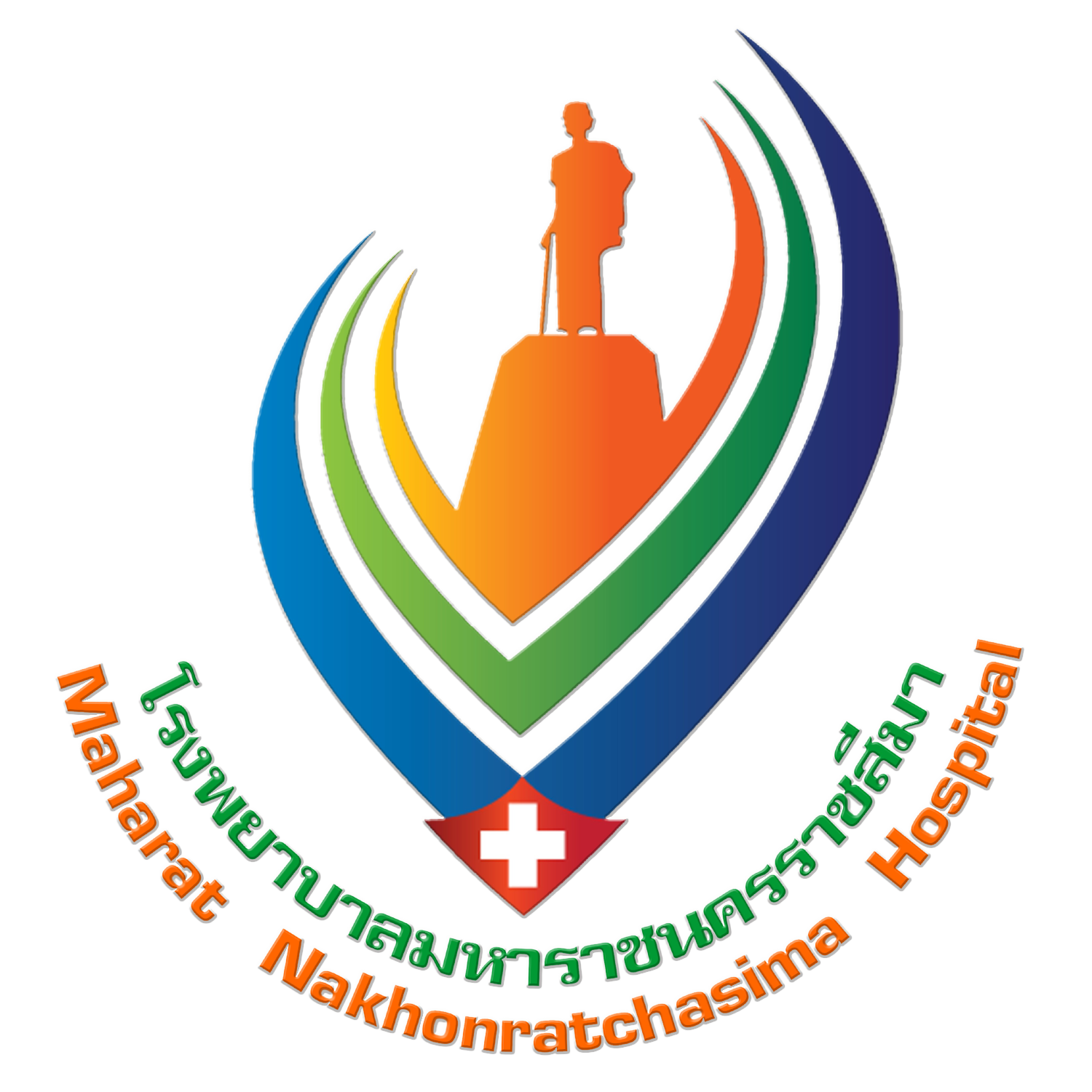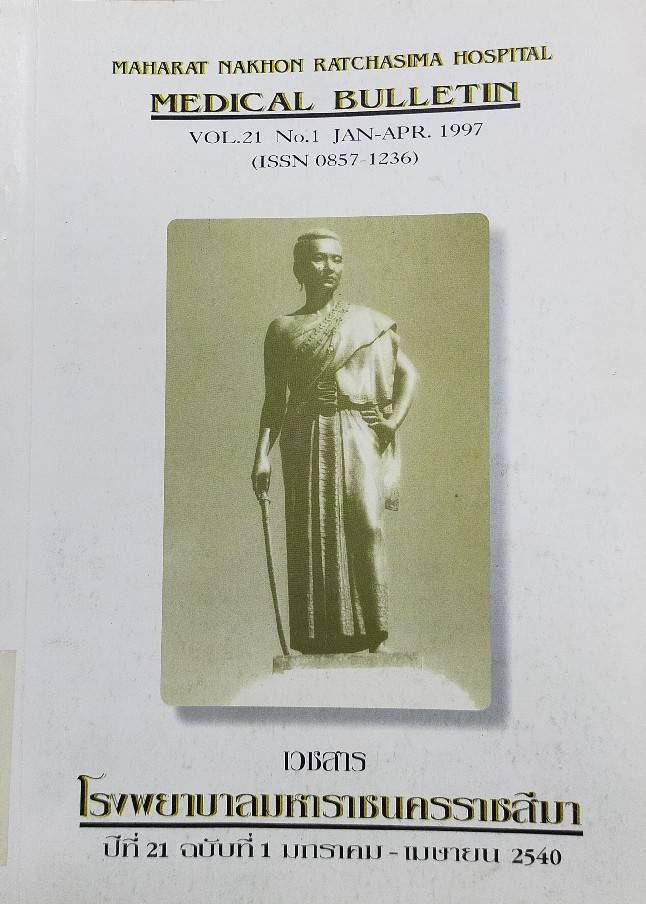CRUSH SYNDROME บทเรียนจากตึกถล่มที่นครราชสีมา และการทบทวนวรรณกรรม
Main Article Content
บทคัดย่อ
ภาวะ crush syndrome เป็นกลุ่มอาการที่มีความรนแรง มีอัตราการเสียชีวิตค่อนข้างสูง เป็นปัญหาทั้งในแง่การวินิจฉัยและการรักษา ได้ศึกษาย้อนหลัง ผู้บาดเจ็บจากเหตุการณ์ตึกถล่มที่จังหวัดนครราชสีมาเมื่อวันที่ 13 สิงหาคม 2536 ซึ่งถูกของหนักทับแขนขาเป็นเวลานาน (prolonged limb compression) จำนวน 22 ราย เพื่อศึกษาลักษณะการบาดเจ็บและปัจจัยที่มีผลต่อความรุนแรงของโรค พบว่า สามารถจำแนกผู้ป่วยออกเป็น 3 กลุ่ม ตามลักษณะความรุนแรงและผลการรักษา กลุ่มที่ 1. จำนวน 7 ราย ถูกทับนานเฉลี่ย 9.9 ชั่วโมง มีอาการแสดงของโรค ไม่รุนแรง มีเพียง 1 รายที่ต้องได้รับการผ่าตัด (fasciotomy) , กลุ่มที่ 2. จำนวน 12 รายถูกทับนานเฉลี่ย18.7 ชั่วโมง เกิดภาวะ crush syndrome อย่างรุนแรง มี 11 รายที่ต้องผ่าตัด (fasciotomy และ/หรือ amputation) มีผู้เสียชีวิต 3 ราย ส่วน กลุ่มที่ 3. จำนวน 3 ราย ถูกทับนาน 42-63 ชั่วโมง จนขา gangrene ทั้ง 3 รายถูก amputation โดยไม่มีภาวะแทรกซ้อนที่รุนแรงและพบว่า การที่แขนขาถูกกดทับเป็นเวลานาน , การที่แขนขาบวมขึ้นอย่างรวดเร็วหลังช่วยออกจากสิ่งกดทับ และการมีปัสสาวะเป็นสีน้ำตาลดำ (visible myoglobinuria) เป็นดัชนีชี้บ่งว่า ผู้ป่วยรายนั้นๆจะเกิดภาวะ crush syndrome รุนแรงในเวลาต่อมา
Article Details

อนุญาตภายใต้เงื่อนไข Creative Commons Attribution-NonCommercial-NoDerivatives 4.0 International License.
เอกสารอ้างอิง
Kikta MJ, Meyer JP, Bishara RA, Goodson SF, Schuler JJ, Flanigan DP. Crush syndrome due to limb compression. Arch Surg 1987;122:1078-81
Labbe R, Lindsay T, Walker PM. The extent and distribution of skeletal muscle necrosis after graded periods of complete ischemia. J Vasc Surg 1987;6(2):152-7
Santangelo ML , Usberti M , Salvo ED , et al. A study of pathology of the crush syndrome. Surg Gyne & Obstet. 1982;154:372-4
Reha WC,Mangano FA , Zeman RK , Pahira JJ. Rhabdomyolysis :Need for high index of suspicion. Urology 1989;34(5):292-6
Tattersall LE , Richards NT , McCann M , Mathias T , Samson A, Johnson A. Acute haemodialysis during the Armenian earthquake disaster. Injury 1990;21:25-7
Adiseshiah M . Round JM , Jones DA. Reperfusion injury in skeletal muscle : a prospective study in patients with acute limb ischemia and claudicants treated by revascu larization. Br J Surg 1992;79:1026-9
Paletta CE , Lynch R , Knutsen AP. Rhabdomyolysis and lower extremity compartment syndrome due to Influenza B Virus. Ann Plast Surg 1993;30(3):172-273
Armstrong JH. Tropical pyomyositis and myoglobinuria. Arch Intern Med 1978;138:1145-6
Caccamo DV , Keene CY , Durham J , Peven D. Fulminant rhabdomyolysis in a patient with dermatomyositis. Neurology 1993;43:844-5.
Soni SN , McDonald E , Marino C. Rhabdomyolysis after exercise. Postgrad Med 1993;94(6):128-132
Visetti E . Costa P. Rhabdomyolysis following life-threatening acute asthma attack Anasthesia 1993;48:887-8.
Mubarak S , Owen CA. Compartment syndrome and its relation to the crush syndrome : a spectrum of disease. Clin Orthop 1975;113:81-9
Reis ND, Michaelson M. Crush injury to the lower limb:treatment of the local injury. J Bone Joint Surg 1986;68-A (3):414-8
Better OS. The crush syndrome revisited (1940-1990). Nephron1990;55:97-103
Sheng CY. Medical support in the Tangshan Earthquake : a review of the management of mass casualties and certain major injuries. J Trauma 1987;27(10):1130-6
Ward MM. Factors predictive of acute renal failure in rhabdomyolysis. Arch Intern 1988;148:1553-7
Muckart DJJ , Moodley M , Naidu AG , Reddy ADR, Meineke KR. Prediction of acute renal failure following soft tissue injury using the venous bicarbonate concentration. J Trauma 1992;33(6):813-7
Better OS. Acute renal failure in casualties of mass disasters. Kidney Int Suppl 1993; 41:S235-6
Ron D, Taitelman U, Michaelson M, Joseph GB, Bursztein S, Better OS. Prevention of acute renal failure in traumatic rhabdomyolysis. Arch Intte Med 1984;144:277-80
ฝ่ายภูมิฟิสิกส์ กองการศึกษาและวิจัย กรมอุนิยมวิทยา. แผ่นดินไหว. พิมพ์ ครั้งที่ 3. โรงพิมพ์กรมอุตุนิยมวิทยา , 2534
Thanomsingh C , Ambua P , Panyaprutpong S , Suksamosorn P. Rescue thigh amputation under the rubble of the Roval Plaza Hotel , Nakhon Ratchasima , Thailand. J
Oder M. The role of reperfusion-induced iniury in the pathogenesis of the crush syndrome. N Eng J Med 1991;324 (20):1417-22
Choudhury NA , Sakaguchi S , Koyano K , Matin AFM , Huro H. Free radical injury in skeletal muscle ischemia and reperfusion. J Surg Res 1991:51(5):392-8
Belkin M , LaMorte WL , Wright JG , Hobson II RW. The role of leukocytes in the nophysiology of skeletal muscle ischemic injury. J Vasc Surg 1989;10:14-9
Hadis T, Grieff M, Lockhat D, Kaye m. Calcium metabolism in acute renal failure due to rhabdomyolysis. Clin Neprol 1993;39(1):22-7
Better OS . Stein JH. Early management of shock and prophvlaxis of acute renal failure in traumatic rhabdomyolysis. N Eng J Med 1990;322(12):825-9
Gabow PA , Kaehny WD , Kelleher SP. The spectrum of rhabdomyolysis. Medicine 1982;61(3):141-52
Marzi I Buhren V , Schutter A , Trentz O. Value of superoxide dismutase for prevention of multiple organ failure after multiple trauma. J Trauma 1993;35(1):110-20
Cheney P. Early management and physiologic changes in crush syndrome. Crit Care Nurs Q 1994;17(2):62-73
Powell WJ , DiBona DR , Flores , Frega N , Leaf A. Effects of hyperosmotic mannitol in reducing ischemic cell swelling and minimizing myocardial necrosis. Circulation 1976; 53(3):l-45-9
Beyersdorf F , Matheis G , Kryger S , et al. Avoiding reperfusion injury after limb revascularization : Experimental observation and recommendations for clinical application. J Vasc Surg 1989;9:757-66
Winburn GB, Wood MC, Hawkins ML, et al. Current role of cryoamputation. Am J Surg 1991;162:647-51
Winburn GB, Wood MC, Hawkins ML. Physiologic amputation prevents myoglobinuria from lower extremity myonecrosis. South Med J 1993 oct;86(10):1101-5
Moretz WH, Voyles WR, Thomas CB, et al.Value of preoperative physlogic amputation. Ann Surg 1961;154:851-8
Mclntyre KE, Bailey SA, Malone JM, Goldstone J. Guillotine amputation in the treatment of nonsalvageable lower extremity infections. Arch Surg 1984;119:450-3
Stil JM, Wary CH, Moretz WH. Selective physiologic amputation : A valuable adiunct in preparation for surgical operation. Ann Surg 1970;171:143-51
Garrison AF, Jelenko C, Brahn G, Wray CH, Moretz WH. The MCG boot: A device which facilitates physiologic amputation. Am J Surg 1973;39:637-41
Gorman JF, Rosenberg JC. Dry ice refrigeration for above-knee amputations. Am J Surg 1967;113:241-5
MacLean JGB , Barrett DS. Rhabdomyolysis : a neglected prionty in the early management of severe limb trauma. Injury 1993;24(3):205-7
Heppenatall RB , Scott R Sapega A , Park YS , Chance B. A comparative study ofthe tolerance of skeletal muscle to ischemia. J Bone Joint Surg 1986:68 A(6):820-8.
Sanderson RA , Foley RK , Mclvor GWD , Kirkaldy-Wills WH. Histological response on skeletal muscle to ischemia. Clin Orthop 1975;113:27-35
Shintani S, Shiigai T. Repeat MRI in acute rhabdomyolysis: Correlation with clinicopathological findings. J Comput Assist Tomogr 1993;17(5):786-91


